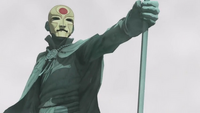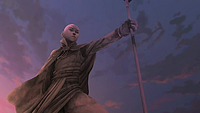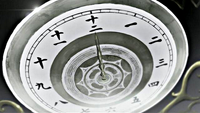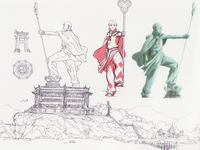- This article is about the island located in Yue Bay. For other similar uses, see Aang (disambiguation).
Aang Memorial Island is a small island located in Yue Bay. It features a massive statue of Avatar Aang that was commissioned by the Fire Nation some time after the end of the Hundred Year War to be displayed in Republic City, where it stands as a symbol of peace and goodwill.[1][2] The statue's pedestal houses a museum, which holds the history of the past Avatars.[1]
History
This island was created to honor the memory of Avatar Aang, who had played a pivotal role in restoring peace and balance to the world by ending the Hundred Year War and creating the United Republic of Nations.
During 170 AG, after Korra aided Tarrlok and his task force with an assault on an Equalists training base, she publicly challenged the Equalist leader, Amon, to a duel on Aang Memorial Island at midnight. When the clock on the island struck midnight, Amon was not present, prompting Korra to eventually give up waiting, believing Amon had not accepted her challenge. However, as she was leaving, she was assaulted and dragged into the museum underneath the statue by several Equalists. Korra managed to fight some of them off by raising part of the ground with her earthbending, but she was soon overpowered by their numbers and immobilized by chi blockers. When the Avatar regained consciousness, Amon emerged from the shadows and told her that he had a plan that would eradicate the world of benders and that he was saving her for last. After Amon knocked Korra unconscious, she experienced her first vision of Avatar Aang.[3]

Avatar Aang's statue was vandalized by the Equalists, who covered its face with a mask similar to that of Amon.
After the Equalists attacked Republic City, they vandalized Aang's statue by hanging Equalist banners from the statue's staff and covering its face with a giant mask, similar to the one worn by Amon. Later, when the Equalists were using their biplanes to destroy the United Forces' battleships, General Iroh crashed one of the biplanes into the statue's head, thereby knocking off the mask and causing it to fall into the bay.[4]
In 171 AG, Aang's statue was pulled from its pedestal by Dark Avatar Unalaq during his assault on Republic City and subsequently thrown into the bay.[5] Within two weeks following the battle, it was returned to its proper position.[6]
Description
Avatar Aang Memorial Statue

The statue of Aang overlooks Republic City.
An enormous metal statue is located on a small island off the shores of Republic City. It depicts a teenage Aang dressed in traditional Air Nomad attire, with the accompanying necklace, which he had worn when Fire Lord Zuko announced the war's end at the latter's coronation. In the figure's left hand is a staff featuring the airbending symbol on its upper end. The figure's left foot rests on a slightly higher surface in the form of a lotus flower. The pedestal on which its other foot stands is octagonal in shape, with upturned tips at each vertex surrounded by railings. This leaves an opening at the back of the sculpture where a paifang gate connects the pedestal with a road linking the island to a dock.[2]
Museum

The museum's clock is visible from many locations.
A museum dedicated to the Avatar is located in the base of the monument. Inside remain numerous relics from past Avatars, which can be enjoyed and studied by the public.[7] A large clock hangs directly above the entrance.
Trivia

This concept art of Aang's statue was very similar to how it turned out in the show.
- Aang's statue and its role as a symbol of peace between the four nations resemble the Statue of Liberty, a gift from France to the United States that was constructed to commemorate the centennial of American independence.
- When Amon captured Korra on the island and threatened to remove her bending, he interestingly did so in a museum dedicated to the importance of the Avatars themselves.
- On the outer ring of the clock are the Chinese numerals one to twelve, indicating the hours. The inner ring is inscribed with unknown characters written in the archaic Seal Script form.
- Aang's statue is the fifth monument shown to be dedicated to a single Avatar, the others being Avatar Kyoshi's statue on Kyoshi Island, Roku's in the sanctuary at the Fire Temple, Yangchen's statues in the Eastern and Western Air Temples, and Korra's in Avatar Korra Park.
- At one point, the creators toyed with the idea that Toph Beifong created the giant metal statue, due to the artistry she displayed throughout the first series.[8]
References
- ↑ 1.0 1.1 Welcome to Republic City. Nickelodeon (April 6, 2012). Retrieved on April 6, 2012.
- ↑ 2.0 2.1 Development art of the Avatar Aang statue.. Korra Nation on Tumblr (February 29, 2012). Retrieved on February 29, 2012.
- ↑ DiMartino, Michael Dante, Konietzko, Bryan (writers) & Dos Santos, Joaquim, Ryu, Ki Hyun (directors). (April 28, 2012). "The Voice in the Night". The Legend of Korra. Book One: Air. Episode 4. Nickelodeon.
- ↑ DiMartino, Michael Dante, Konietzko, Bryan (writers) & Dos Santos, Joaquim, Ryu, Ki Hyun (directors). (June 23, 2012). "Endgame". The Legend of Korra. Book One: Air. Episode 12. Nickelodeon.
- ↑ DiMartino, Michael Dante (writer) & Graham, Ian (director). (November 22, 2013). "Light in the Dark". The Legend of Korra. Book Two: Spirits. Episode 14. Nickelodeon.
- ↑ Hedrick, Tim, Hamilton, Joshua (writers) & Heck, Colin, Zwyer, Melchior (directors). (June 27, 2014). "A Breath of Fresh Air". The Legend of Korra. Book Three: Change. Episode 1. Nickelodeon.
- ↑ The Legend of Korra—The Art of the Animated Series, Book One: Air, page 36.
- ↑ Bryan Konietzko on the DVD commentary for "The Voice in the Night".